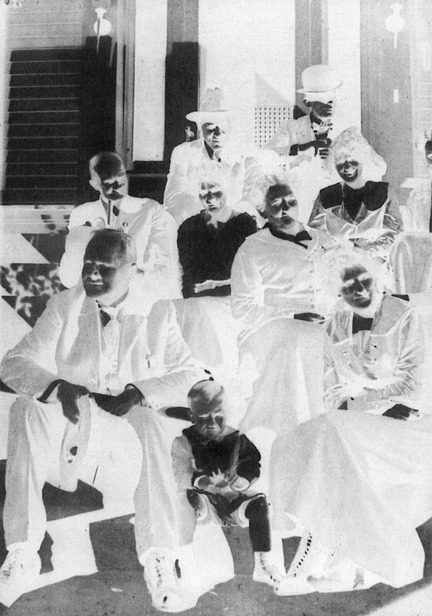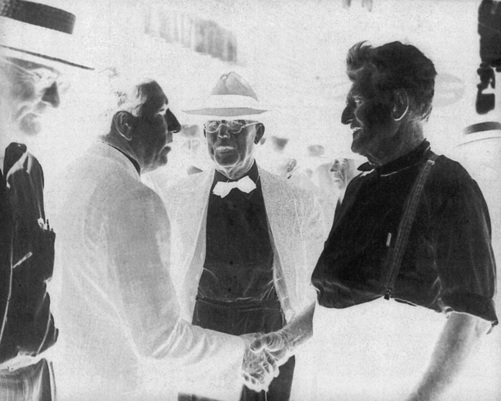The History of Florida (88 page)
Read The History of Florida Online
Authors: Michael Gannon
Tags: #History, #United States, #State & Local, #Americas

portionment system that ensured the region’s control until the late 1960s,
when the courts ruled that both houses of a state legislature had to be ap-
portioned based on population size—the “one person, one vote” principle.
Florida Politics · 419
The Early Twentieth Century: Segregation Clashes with
Development Demands
Throughout the period from 1900 to 1940, state politics were dominated by
a few central issues. National developments, especial y those that occurred
within the Democratic Party, occasional y impacted state politics in sig-
nificant ways throughout this era from the age of progressivism to the New
Deal. Race was never far from the forefront of state politics and played a
particularly prominent role throughout the era from 1900 to 1924.
Development and who would determine its course in the state were other
dominant concerns in the first decade of the twentieth century. Progressive
Democrats like Wil iam Jennings (1901–5), Napoleon Bonaparte Broward
(1905–9), and Broward’s successor, Albert Gilchrist (1909–13), control ed
the governor’s office, but because of their limited ability to carry out their
economic reforms and sharp divisions within the legislature, they gradual y
yielded power to more entrenched, conservative forces in the state.
The opponents of progressivism and even some of its allies believed that
a cheap land policy and private development, even in areas as environmen-
tal y sensitive as the Everglades, were essential to the state’s emergence from
poverty. At this stage in Florida’s development, environmental concerns
proof
took a distant second place to concerns about economic growth and ex-
pansion of the population. Florida’s flirtation with progressivism was thus
a short-lived affair, and by 1912 political power had fallen into the hands of
pro-business spokesmen.
By the end of World War I, land developers had descended upon Florida.
With the rise in popularity of the automobile, it became commonplace for
people to vacation in Florida. Many tourists stayed on, and developers even
sold land sight unseen to northerners persuaded by fantasy advertisements.6
The gradual involvement in the war effort and the social dislocation that
resulted from mobilization caused considerable consternation in the South
over race relations. Having recently imposed segregation, white southern-
ers by 1914 were in no mood to have this system altered. By contrast, black
southerners viewed the war as an opportunity to cast off the oppressive
blanket of segregation by demonstrating their patriotism.
Racial patterns in the South were additional y complicated by the mas-
sive migration of African Americans to the Midwest and Northeast begin-
ning around 1910 to escape the oppression of segregation and the economic
havoc created by the boll weevil’s devastation of the cotton crop. They were
also drawn to the North by the promise of economic opportunity and

420 · Susan A. MacManus and David R. Colburn
proof
Governor Sidney J. Catts (1917–21) is shown here (
seated, left front
) with his family on the
Governor’s Mansion steps. A resident of Florida only five years when he announced for
governor, Catts campaigned in the rural counties as an anti-Catholic demagogue. Yet
his administration was characterized by numerous progressive programs, including
the penal reform, support for organized labor, and improved status for women. And
his official stance toward Catholicism was conciliatory (his executive secretary was
Catholic, and his son Rozier, with his father’s blessing, married a Catholic).
greater freedom. Labor agents from northern industries and railroads de-
scended on the South in search of black workers.
As the massive exodus of African Americans continued from the north-
ern counties of Florida during the war years, Governor Park Trammell
(1913–17) and his successor, Sidney J. Catts (1917–21), essential y ignored it.
Trammel , no friend of black Floridians, had disregarded the lynching of
blacks when he was the state’s attorney general and during his governorship.
Florida Politics · 421
When the NAACP complained about these lynchings, Catts denounced the
organization and blacks general y.
Catts changed his tune when white business leaders, especial y in the
lumber and turpentine industries, began to complain that the continued
outmigration of blacks was having a devastating effect on labor availability
and labor costs in Florida. Suddenly, Catts urged blacks to stay in Florida
and called for unity and harmony among the races. Few black citizens lis-
tened to him or were intimidated by threats of violence. The migration con-
tinued to escalate as a quiet protest against racial conditions in the South.
During the early 1920s, white Florida gradual y suppressed the aspira-
tions of its remaining black population. Its governors played a willing hand
in this process. They defended their actions by asserting the inferiority and
dependence of the black race and received ample encouragement from the
writings of anthropologists and popular authors who claimed that scientific
evidence documented black inferiority. Black citizens, however, resisted
efforts to reimpose segregation by whatever means were at their disposal.
In Ocoee, black residents marched to the polls in an effort to vote, only
to be physical y assaulted and to have their homes and property seriously
damaged.7
The white commitment to maintaining segregation knew few bounds,
proof
however. In Perry and Rosewood, blacks were killed and their property de-
stroyed fol owing al eged assaults upon white women. When blacks in Rose-
wood tried to defend themselves against a white mob, their public build-
ings, churches, and homes were burned to the ground, six were reported
murdered, and all were chased from the community in January 1923, never
to return.8 The promise of the war years and the great migration had been
completely snuffed out in Florida by 1924, and state leaders were willing ac-
cessories in this process.
Although Catts and his allies remained political factors throughout the
1920s, the Democratic Party returned to the hands of party stalwarts in 1920
with the election of Cary Hardee (1921–25), who took office just in time to
bask in the prosperity of the economic boom in south Florida. The eco-
nomic development and population expansion that Florida had long sought
began to stir, and Florida’s leaders turned their backs on Catts and his al-
lies and eagerly embraced the new investors. Unfortunately, like al rol er
coasters, Florida’s economy suddenly lurched downward in late 1925 when
the land bubble burst, money and credit ran out, and banks and investors
abruptly ceased trusting developers. State leaders had done little to regulate
speculators or to restrain the massive expansion.

422 · Susan A. MacManus and David R. Colburn
The Depression: Fiscal Battles, Taxes Dominate State Politics
Florida became a metaphor for the boom and bust years of the 1920s, and no
state experienced the highs and lows any more thoroughly. By the time the
stock market col apsed in the fall of 1929, Florida was already mired in four
years of depression.9 The financial col apse paralyzed political leaders and
left the state unprepared to meet the crisis. During this period, conserva-
tive campaign slogans, such as “no new taxes” and “make government run
more efficiently,” emerged. They became powerful political ral ying cries for
decades to come.
Governor Doyle Carlton (1929–33) attempted to counter the political in-
eptitude by urging the legislature to raise taxes to reduce a state deficit of
$2.5 million and to assist counties in paying off their bonds. He also sought
a gasoline tax to pay for roads and to keep schools open. But the gover-
nor’s tax plan encountered stil stiff opposition from representatives whose
proof
Senator Claude D. Pepper greets some of his Florida constituents in the 1940s. A vig-
orous advocate of President Roosevelt’s New Deal, Pepper brought many millions of
federal dollars to Florida during the Depression and war years. In his last years, as a
member of the U.S. House of Representatives, he became the nation’s staunchest ad-
vocate for senior citizens.
Florida Politics · 423
counties had small debts and who felt they were being forced to pay for the
sins of those with large debts. At one point Carlton, total y exasperated,
pleaded with legislators, “If the program that has been offered does not meet
with your liking, then for God’s sake provide one that does.”10
Carlton’s successors, David Sholtz (1933–37) and Fred Cone (1937–41),
refused to follow Carlton’s controversial lead. Both blamed Florida’s prob-
lems on irresponsible leadership and called for a return to fiscal restraint,
balanced budgets, and sound business principles. Decimated by the state
and national depression, Florida looked to the federal government more
than most states did for assistance.
Roosevelt’s election and his New Deal programs provided the lifeline
that kept Florida afloat during the 1930s. The Agricultural Adjustment Act,
in particular, provided crucial assistance for financial y desperate farmers
and grove owners. For many, it was not enough. Florida continued to suffer
greatly during the Depression, and as late as 1939 no end seemed in sight.11
World War II: Growth Begins, Tourism Takes Off, Fights for Political
Power Intensify
World War II reinvigorated Florida. The state became a training center for
proof
troops, sailors, and airmen of the United States and its allies. Highway and
airport construction was accelerated so that, by the war’s end, Florida had
an up-to-date transportation network ready for use by its citizens and by the
visitors who seemed to arrive in an endless caravan.12
Led by Governor Spessard Hol and (1941–45), Florida worked closely
with the Roosevelt administration and the War Department to secure
federal funds for Florida. Hol and’s successor, Governor Mil ard Caldwell
(1945–49), dramatical y expanded activities of the Florida Department of
Commerce to attract new business and visitors into the state. Commerce
Department employees seemed to take particular pleasure in sending pho-
tographs of beautiful young women, scantily clad and lounging round a
pool or at the ocean, to northern newspapers in the dead of winter.
Caldwell and his successors also began a series of trips to the North and
Midwest in an effort to recruit more business. Florida’s sales pitch to pro-
spective business interests and residents emphasized low taxes, a healthy
environment, cheap land, and a pro-business political climate. These trips
expanded in subsequent administrations to include foreign countries as
Florida sought to internationalize its economy and its tourism. The state
modernized its roads to accommodate increasing automobile traffic, and
424 · Susan A. MacManus and David R. Colburn
Caldwel ’s successor, Governor Fuller Warren (1949–53), pushed through a
fence law to keep the cattle from crossing the roads, killing the tourists, and
